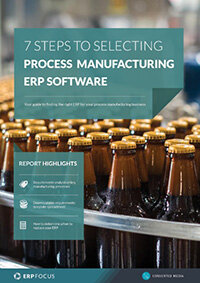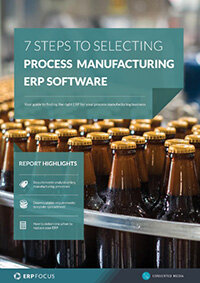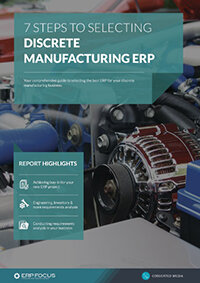Top requirements selecting process manufacturing ERP (Guide)
Selecting a new process manufacturing ERP can be a complicated task.
There are so many moving parts in a business, especially a manufacturing business, that it can be difficult to determine:
- If you need a new process manufacturing ERP?
- What are the benefits of a process manufacturing ERP?
- What metrics should a process manufacturing ERP track?
- What features should be included in my process manufacturing ERP?
- What types of questions should I be asking a process manufacturing ERP vendor?
We've created this guide to help you through the process of determining whether you need a new ERP, and how to build your requirements and select a new process manufacturing ERP.
Signs you need a new process manufacturing ERP
First things first: do you need a new process manufacturing ERP? Business can be rolling along nicely for years, batch after batch, but then you begin to wonder if it could be better. Is it time for a new process manufacturing ERP? Here are some indicators that it's time to find a new process manufacturing ERP.
Regulatory compliance is a burden
You deal with cGMP and HACCP. You still need to worry about hazardous materials and maybe even environmental inventory tracking. The old ERP was once perfect but your compliance needs have changed.
You will find the newer the system, the more compliance requirements are built in. You will also find today’s process manufacturing ERP has extensive reporting capabilities that enable quick and easy preparation of data to meet any regulator’s wildest desires.
Your equipment schedule and process could be improved
The equipment needed in a process manufacturing environment can be expensive. Your business depends on mixing, refining, and otherwise converting your recipe into your finished products. You want that equipment running all day, every day, giving you your money’s worth on your big investments.
You need to plan your jobs carefully to meet the order dates with the maximum uptime on the machinery. The time between process cycles must be kept to a minimum. Changeovers must be planned to delay costly cleanouts between production runs. At the same time, you want to produce as much grade A as possible to keep revenues at the highest levels.
New process manufacturing ERP systems will come with planning and scheduling tools to enable the maximum production possible while at the same time ensuring all equipment maintenance is up to date. ERP can also connect directly to the equipment over your network, so the ERP knows in real-time the status of production and the quality levels of the product so you can tweak the processes immediately if needed.
Your ERP is generic and heavily customized
When your current ERP system was new, the selection of software was much more limited than today. Your ERP might be a generic system that you have learned to work with. You might have had to heavily customize the system to meet your requirements. If either of these scenarios rings true, it might be time to start considering new process manufacturing ERP systems.
Right out of the box you will find features you have wished you had for years. Yesterday’s workaround will become tomorrow’s work-through. Not only are you likely to find a good ERP that was developed for your particular process manufacturing niche, but you will find that it can be conveniently and easily modified to each user's preferences.
The benefits of process manufacturing ERP
You may call it an accidental benefit, but one thing that an ERP implementation forces on an organization is a thorough examination of its business model and practices, and process manufacturing benefits disproportionately from this examination. By its very nature, process manufacturing tends to be more flexible and dynamic over time. As a result, many business practices are the result of evolution, instead of a thoughtful and well-executed strategy. In process manufacturing, you can almost always accommodate one more special customer need, until, after a while, your business model hardly resembles what your manufacturing, service, or systems were designed for. The misalignment between how the business was designed to run and how it actually does run will be highlighted in a number of ERP design issues.
Centralization and standardization of business data
A key benefit of ERP for process manufacturers is the standardization and centralization of business data. This not only reduces organizational redundancy, it aligns the business around a common version of reality. Because the concept of master data is new to many companies, it is sometimes seen as additional work, instead of less work.
Aligning the business around a common version of reality cascades naturally from only having one version of the truth: one bill of material, one recipe, one standard cost, one forecast. Determining what the right “one” is can be an argumentative process within an ERP implementation; in the long run it is more efficient to simply decide who owns any given data and administer it as a benevolent dictatorship. The reason is that every functional area has a different agenda, and wants the math slanted toward their agenda. Supply chain wants liberal conversion factors on bills of materials so they don’t run short; cost accounting wants conservative conversion factors so that standard costs are as low as possible. A common version of reality pays even more dividends in standardizing the naming conventions people use to describe products and materials.
The recognition of data consistency’s benefit for a process manufacturer grows over time, as users of ERP notice problems have just quietly disappeared. Do not be surprised if eventually, the importance of data control is recognized as a strategic issue, and administered on the corporate level.
Reducing redundancy and duplication
The reduction in redundancy occurs as a result of multiple functional areas not having to keep up parallel versions of the same data in different legacy systems. For instance, the supply chain team within a process manufacturer almost certainly maintains a bill of material structure used to create internal manufacturing work orders, forecasts, and to plan capacity. Cost accounting needs to know the same things but is likely to keep their own separate bill of materials with different naming conventions in the cost system. It is possible that there is a production scheduling tool that utilizes yet another stand-alone bill of materials.
Generally, development or engineering owns a spec sheet system that details what a product is, and all of the components that go into it. Merchandising might have a specially written variation of the bill of materials for replenishing sample materials.
All of these different bills of materials are essentially the same information, yet they are all uniquely different as well, and they all require independent resources to update and maintain them. This phenomenon occurs in a variety of data categories and a variety of job functions throughout a typical process manufacturing business. It does take some amount of organizational discipline to capture this benefit because having only one source of master data eliminates a fraction of many peoples’ jobs while appearing to be new and additional work for the person who is maintaining the data in ERP.
What metrics should a process manufacturing ERP track?
Implementing process manufacturing ERP can be the key to unlocking success in many businesses. This success, however, relies upon the system’s users tracking and monitoring the right sets of system data. Here are four process manufacturing metrics that your ERP can measure and track that may provide your business with some interesting insight.
1. Batch changeover time
Changeover between products or lots is important to any process manufacturer. This can be relatively simple, like a change in colors at a paint company, or very complex such as that at a drug manufacturer where the ingredients in one process might react unexpectedly with an unrelated product using the equipment next.
What is common to all process manufacturers is during these changeovers, nothing is being produced and no profit is being earned. Process manufacturing ERP can help by analyzing the components of the change to allow the separation of internal components from externals. Looking at personnel who have worked on the change might pinpoint that certain people are faster or make fewer mistakes than others. The benefit? Improved customer satisfaction through a reduction in unproductive time.
2. Capacity utilization rates
Process manufacturers often employ unique and expensive equipment required for their processes. The rates of production for each product and operation should be contained in any process manufacturing ERP worth its salt.
By measuring these rates, ERP scheduling tools can line up the operational processes for one product with the processes for another product so that equipment is optimally in use and no time is lost at all. Ideally, the equipment is making something 100% of the time it is not down for planned maintenance or to clean out after a production run. Capacity utilization is an important process manufacturing metric for efficiency.
3. Energy cost per unit
Production in process industries often requires heating and cooling products at specific rates during processes. Large pumps might be used to increase or decrease pressures within the equipment. The entire plant might need a specific atmospheric makeup and tightly controlled temperature and humidity within the walls. All those factors result in high energy costs.
Process manufacturing ERP should measure the rates of energy consumption throughout batch processes and allow some degree of control as well as provide an alert when the consumption rates exceed the planned rates. Tracking energy cost per unit as a primary process manufacturing metric gives you the ability to reduce energy costs and, therefore, increase profits.
4. Revenue per employee
This is a measure of productivity that helps us attain profits. Process manufacturers often have highly automated workflows with only a few employees monitoring the gauges. Each employee has associated costs. If these costs begin to outweigh the value added to your processes, profitability will suffer. With this in mind, revenue per employee becomes a crucial process manufacturing metric to monitor.
There are a wide variety of process manufacturers making different products. Each one has its own goals and improvement plans. These metrics are only a sample, but they demonstrate a number of areas where your ERP can give you an overview of business success.
Essential features for a new process manufacturing ERP
There are a lot of different requirements to consider when shortlisting process manufacturing ERP. If your product is toothpaste, yours are quite a bit different from another manufacturer that produces motor oil but both are process manufacturers. It can be hard to match features across multiple industries, so we've pulled together some requirements that serve across many different industries.
This is also the time for you to map out your product developement needs including your key requirements for how developing new products will work in a new system.

We cover the product development needs for process manufacturers more thoroughly in our process manufacturing ERP selection guide.
1. Coproducts and byproducts management
A coproduct is something leftover from production that can also be sold in a different market. Your business might be making sugar for humans from beets. You also yield livestock feed from the same beet. A byproduct is something produced in the making of something else. Your business is producing gasoline and asphalt is a byproduct of the process. These exist in many process industries, so a good process manufacturing ERP must help manage them.
2. Automated input and output
Many processes run over long periods of time and can be designed to read sensor input into the ERP and adjust as temperature, pressure, and other variables change during the process. Output from a process might move through different paths or secondary processes automatically by triggering a PLC or programmable logic controller. The PLC might open a gate and send material to one customer while a concentration is high and then to another customer while the same concentration is lower.
Make the right software choice using this seven-step guide to selecting process manufacturing ERP
3. Multiple units of measure
The same product might need more than one unit of measure. The nominal output could be a 16-ounce bottle and the volume of fruit measured as a factor of the weight.
4. Catchweight
In some cases, process manufacturing ERP must manage inexact measurements. For example, chickens are unloaded from a truck for processing. The catchweight might be 10 lbs. each but any particular bird might be as much as 1 lb. more or less than the catchweight. At the other end of the process, the consumer expects exactly one pound of chicken in his frozen dinner ERP has to convert from an approximate inventory to precise inventory values.
5. HACCP
Hazard Analysis and Critical Control Point is a food industry method of managing food safety through analysis and control of biological, chemical, and physical hazards from procurement to consumption of the products. Your process ERP should help monitor your process and provide the measurements needed.

For further process manufacturing ERP features advice including quality control, lot traceability, scheduling, you can find more information in our full guide to process manufacturing ERP.
6. REACH
The European Chemicals Agency ensures the benefit for human health and the environment and companies are required to comply with legislation regarding the safe use of chemicals. Almost all process manufacturers have similar compliance regulations, so ERP should be able to collect this data effectively.
Questions to ask your process manufacturing ERP vendor
So, you're ready to start your journey toward a new process manufacturing ERP system to help manage your business. You are in the process business and you want a list of questions to help narrow down your selection of the many vendors you must choose from.
Do they understand process manufacturing?
You know this means you make product in weight, length, volume, etc. and not in piece units. You know this means the materials you introduce into your process can never be returned to inventory as they change by mixing to catalyzing or something else. If a prospective ERP vendor cannot define process manufacturing so you know their words are no more than a sales pitch, find another vendor.
What is their experience?
Have they actually worked with other process manufacturing companies? Or have they developed niche process manufacturing ERP systems? Or do they just sell systems the boss and their training manual told them will work for your industry? You would like someone who understands your process manufacturing ERP needs at an internal level.
What is the core of their system?
Many ERP systems are based on accounting. They added an ERP inventory module and then a work-in-process module that might be process-based. You probably would prefer something that has powerful manufacturing capabilities at its core.
How does it handle variability?
You can add a little of this to a recipe and remove a little of that. You can cook it a little longer or run the pump a little slower. Often these variations are necessary because of environmental factors such as today’s relative humidity. Sometimes they are needed to balance the purity of the ingredients you have today.
How does the ERP track batches and grades and other factors?
You need to track the end batch as well as batches of ingredients used in that end batch. Their might be different grades of product at the end to be identified and tracked. The shelf life of today’s production might be different and your customer will need to know.
Can the ERP manage by-products and co-products?
Any system will allow the combination of ingredients into a specific end product. Many processes will yield other products that need to be inventoried and tracked along with the specified end product.
Will the vendor teach me to manage my ERP?
There are ERP vendors whose main objective is to capture you as a consulting customer. That is not wrong. But, if your preference is to manage your own business, you will need to be adept at managing your process manufacturing ERP too.
These are only a few key questions. Certainly there are others you should ask too.
This guide should give you some basic idea of what you should consider when selecting a process manufacturing ERP, we have a further guide available that goes into more detail that is available to download.
Free white paper

7 Steps to Selecting Process Manufacturing ERP
Your guide to finding the right ERP software for your process manufacturing business

Featured white papers
-

7 steps to selecting discrete manufacturing ERP
17 pages of ERP selection advice and industry requirements analysis
Download
Related articles
-

Must have quality control features for process manufacturing ERPs
Critical features that your process manufacturing ERP must have for quality control processes
-

CMMC Compliance: What Aerospace and Defense Manufacturers Need to Know
Key insights on CMMC compliance, deadlines, and securing DoD contracts with CMMC 2.0 certificatio...
-

Five ways Drum-Buffer-Rope scheduling can boost your manufacturing performance
Exclusive guest blog from Genius ERP on DBR scheduling in ERP

